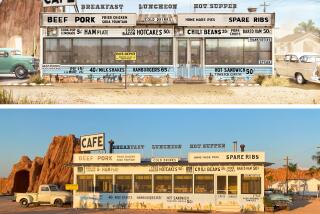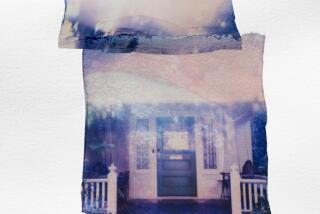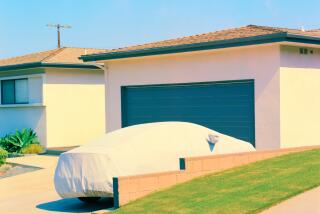Arcosanti: A Dream Endures in the Desert
ARCOSANTI, Ariz. — It had been a slow day for the tour guides at Arcosanti, a partially constructed futuristic city that squats on a mesa 65 miles north of Phoenix. But by 4 o’clock, six people had wandered into the visitor center and paid their $4--sufficient customers to begin a tour.
A guide assembled the group around a model of the completed city. The exhibit was showing its age. Imitation shrubbery--the kind used on miniature train sets--had crumbled, coating the swooping arches of the town with pale green fuzz.
As the guide gestured, his hand accidentally brushed a structure. The top half of a megastory apartment building toppled into the green dust.
“We’ll have to glue that,” the guide said.
Arcosanti itself is a model, or a prototype, of an ideal city. Begun in 1970 by visionary architect Paolo Soleri, it has been one of the more audacious attempts in our time to make a fantasy real. Early on in the project’s history, Newsweek reported: “As urban architecture, Arcosanti is probably the most important experiment undertaken in our lifetime.” An architecture journal predicted the work would have more impact “than anything now standing in steel, concrete and glass.”
‘Too Tall an Order’
But, like the model in the visitor center, Arcosanti has begun to deteriorate.
Crabgrass is creeping over the walkways. One of the housing units shows cracks. Some people have already anticipated the planned city for 5,000 eventually falling into ruin.
“It was too tall an order. It was simply too big,” said Michael Graves, one of the nation’s most renowned post-modernist architects and a professor of architecture at Princeton University. Among Graves’ best-known work is the Whitney Museum of American Art in New York and the San Juan Capistrano Library.
In Soleri’s view, however, architects are not the ones to judge his city. His peers, said the wiry 68-year-old, are philosophers and theologians, not builders.
“Of course Arcosanti is a failure in the sense that he has been working on it for nearly 20 years and very little has been accomplished,” said John Cobb, a professor at the School of Theology at Claremont. Cobb said he has kept an eye on Soleri’s city since its inception because he is interested in alternatives that preserve the environment.
‘Salvation of the Universe’
Given the plodding fund-raising technique (Arcosanti has been built largely on the fees paid by student laborers and the sale of Soleri’s ceramic wind bells), Cobb said, “It would be astounding if Arcosanti were not full of cracks, so to speak.” But the cracks and the crabgrass are really not the point, Cobb said. What matters is Soleri’s goal: “The salvation of the universe.”
Soleri is intent on a vision of universal perfection. Arcosanti, only 3% completed at this time, is but “a tiny step on a long, long journey,” Cobb said.
Architect Graves does not discount Soleri’s journey. He said there are innumerable examples of Gothic churches and other structures that were never completed but were worthy nonetheless. To be incomplete, he added, is not necessarily the same as to fail.
Paolo Soleri is not an outgoing man on first meeting. Skill in dealing with people was the province of his wife, Corolyn (Colly), said Cobb, who had observed the couple together.
Colly Soleri, who recruited student workers for Arcosanti, died five years ago. “Her death was one more blow toward the project’s possible realization,” Cobb said. (Soleri has two grown daughters, Daniela and Kristine, a dancer living in Los Angeles.)
Always a loner, Soleri has retreated even more in recent years from the small community of about 40 people who live at Arcosanti. Spending part of each week at his Cosanti Foundation in Scottsdale, he lives at Arcosanti in a sparely furnished niche in one of the concrete buildings. His quarters are dominated by a large drafting table and an RCA television. (“I’m a TV addict.”)
Every morning, he makes his own breakfast, then gets to work writing or drafting new designs. His window opens onto the public studio space downstairs, so that his fellow workers must have the feeling their leader is always watching them.
His staff has been instructed not to make appointments for him from noon to 2 p.m. every day. That’s when he swims 30 laps in the Arcosanti pool, builds himself a salad for lunch, and takes a nap--”in that order,” he said.
In the evenings, he is alone again. He watches the national news and “one hour of junk” on television, and cooks his dinner--often some Italian dish he watched his mother make when he was a boy in Turin, Italy.
At Odds With Philosophy
The solitary life style is at odds with Soleri’s utopian philosophy, which deems that crowding is essential for human happiness.
“We, our organisms, are a crowding of cells and particles,” he said. “Life is a crowding of events and things. Without crowding, you don’t have civilization--you have isolated animals.”
The theme that has guided Arcosanti and Soleri’s other projects (most of which exist on paper, only) is the idea that cities should be built high and compact, with the surrounding land preserved as wilderness.
Unlike Los Angeles or Phoenix, places congested with machines, Soleri’s Arcosanti would be congested with people--people sharing, observing each other, interacting. There would be no need for automobiles since it would take only 20 minutes to traverse the city on foot. Theaters, hospitals, shops and services all would be contained within this area.
Arcosanti residents would live in high-rise buildings, but all around them would be unspoiled nature.
“My naive assumption was that society would respond to this idea,” Soleri said.
Enthusiastic Response
Society did respond, at first. In the early ‘70s, wave after wave of young people congregated at Arcosanti for the jubilant atmosphere, for the chance to see rock performers like Stephen Stills and Jackson Browne under the desert stars, for the opportunity to be part of a happening.
Many of them left, Soleri said, “when confronted with toil and sweat--making a form or digging a ditch or fixing plumbing.”
Since that time, Arcosanti has not turned out to be the prototype Soleri envisioned. There are no Arcosanti-like complexes sprouting across the land.
While Soleri believes that some developers have taken note of his ideas, Michael Graves said that, to the contrary, developers seem ever more intent “on making sure that we destroy our landscape.” From Paris to London to New York, he said, suburbs are being built “more vigorously than ever before.”
Bob Harris, dean of the school of architecture at USC, says it may not ultimately matter whether schemes like Soleri’s are realized or are adopted by others. “They serve as a kind of benchmark against which we can assess other ideas.”
A Tourist Attraction
Charlotte Buchen, who first interviewed Soleri for a Arizona newspaper 30 years ago and who has watched the project since, observed that Arcosanti has never attracted the sort of growth that would suggest it is a successful community. The desert between the exit off Interstate 17 and the concrete domes of Arcosanti remains undeveloped except for a mini mart, gas station and a couple other businesses that service tourists going to see Soleri’s city.
“What happened,” said Buchen, who now owns a public relations firm in Phoenix, “is that Arcosanti became a tourist attraction. When people come to Phoenix they say: ‘You have to see Taliesin West, and by all means, go to see Arcosanti.’ ”
The other architectural attraction Buchen refers to, Taliesin West, was the workshop of Soleri’s former teacher, Frank Lloyd Wright. Bringing with him a doctorate in architecture, Soleri came to this country to study with Wright in 1947.
But Soleri--who, in his own admission can be “overbearing”--was not able to work comfortably with Wright and the two parted ways.
On a recent day, power saws chirped at Arcosanti. A lone figure slapped at concrete with a trowel.
Construction goes on here, at a quiet pace.
To escape the construction hubbub, Arcosanti residents sometimes follow the trail that leads down a gorge and up the other side of the canyon. The sculpted buildings, which, up close, appear dispirited and droopy, look--from the other side of the gorge--as if they could take flight on a canyon updraft.
The view from here gives one an entirely different feeling for Soleri’s city, and it is perhaps more the way Soleri would wish it to be regarded--from a distance. He said he is not concerned with how he will be evaluated within his lifetime; the concepts he is working with fit into a very long-range scheme.
“Perfection,” he said, “is something that can only be achieved at the end of time.”
More to Read
Sign up for The Wild
We’ll help you find the best places to hike, bike and run, as well as the perfect silent spots for meditation and yoga.
You may occasionally receive promotional content from the Los Angeles Times.






